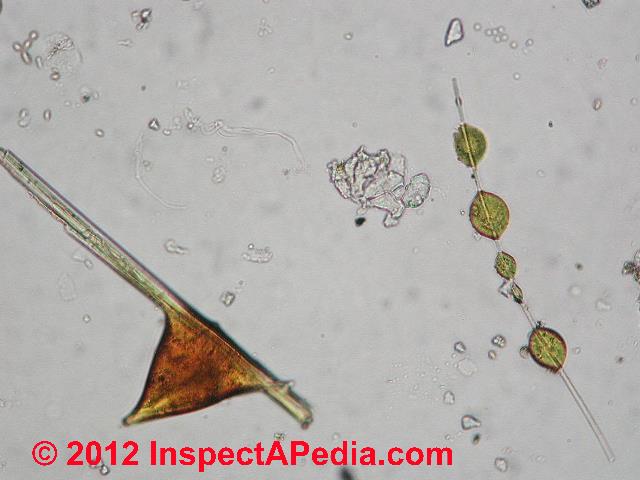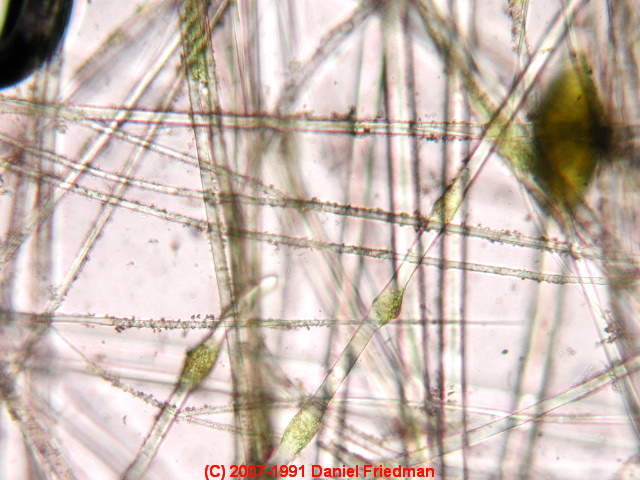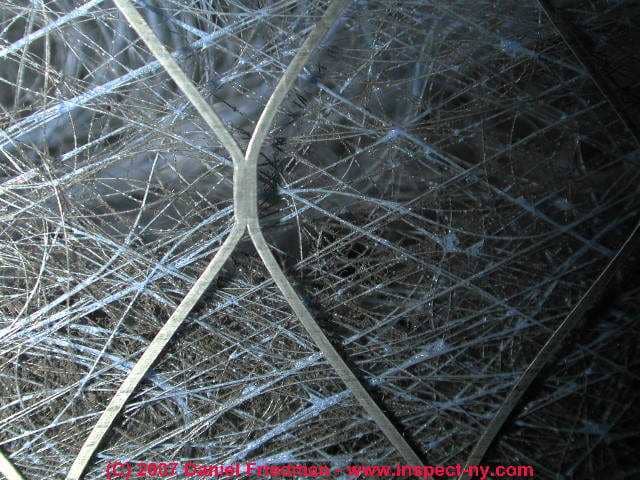 Fiberglass, Air Filters & IAQ
Fiberglass, Air Filters & IAQ
Are fiberglass air filters a source of indoor fiberglass contamination?
- POST a QUESTION or COMMENT about reader questions concerning fiberglass particle shedding by air filters, about labs and investigators who may fail to accurately test for small fiberglass fragments, and the variations in fiber size in different HVAC filters.
Air filters & airborne fiberglass:
This article discusses HVAC system air filters as a potential source of airborne fiberglass versus the role of air filters as a means of removing fiberglass or other particles from indoor air:.
We describe a shortcoming of some field and lab investigations for airborne fiberglass: failure to sample or test for very small fiberglass particles.
This website answers almost any question you might ask about air filters for heating or air conditioning systems.We explain how an air conditioning service technician will diagnose certain common air conditioning system failures or defects.
InspectAPedia tolerates no conflicts of interest. We have no relationship with advertisers, products, or services discussed at this website.
- Daniel Friedman, Publisher/Editor/Author - See WHO ARE WE?
Air Filters and Fiberglass Contamination in Indoor Air
Air filters and their contribution to fiberglass fragments found in building air and dust
 In our experience coming from both field inspections and from operating our own forensic microscopy lab for many years, concern for filter shedding, say of fiberglass fragments, is usually not a significant issue.
In our experience coming from both field inspections and from operating our own forensic microscopy lab for many years, concern for filter shedding, say of fiberglass fragments, is usually not a significant issue.
The contribution of an air conditioning or heating furnace air filter fiberglass to the overall level of airborne or dust-borne fiberglass particles in a building is likely to be insignificant, probably below the limits of detection by other than the most rigorous means, and certainly in most buildings will be insignificant compared with the contribution of other fiberglass sources such as building insulation in unprotected ceilings or walls.
Photo just above: a fiberglass fragment showing the characteristic concoidal fracture on its left end that helps identify this material in the lab.
In fact most fiberglass that we find in building air and dust seems to originate in building insulation, especially where there is traffic or air movement in and out of areas where fiberglass insulation is exposed, and more so if that insulation is mechanically damaged such as by being walked-on.
A second source of fiberglass particles in buildings is from damaged fiberglass-lined HVAC ductwork, such as ducts that use an internal fiberglass liner that was damaged by an inept attempt at mechanical cleaning.
If necessary we can usually identify the source of the dominant fiberglass fragments in building air and dust. Samples of settled dust and building air are compared with samples of fiberglass from common building sources such as fiberglass building insulation and fiberglass HVAC duct insulation.
Our next photo illustrates the variation in fiberglass fiber diameter as well as resin color and deposition patterns. The rsin is a binder that helps hold fiberglass together in insulating batts or blankets.
We describe this variation further below.
Fiberglass fiber metric consistency and the color of fiberglass binders are often sufficiently distinct to permit positive identification of the source of fiberglass fragments in the building environment.
Also see our article on laboratory identification of fiberglass found
at LAB IDENTIFICATION OF FIBERGLASS
HVAC Air Filters Are More Likely to Reduce than Increase the Indoor Airborne Fiberglass Particle Level
In sum, it is very doubtful that a fiberglass-based HVAC air filter is a meaningful contributor to the total load of airborne fiberglass particles in a building. There are simply too many enormously larger fiberglass particle sources that overwhelm the measurement.
Any air filter, properly selected and installed and maintained, will be expected to reduce the overall level of airborne particles, including fiberglass fragments which are contributed to the building air and dust from other building sources.
Do field investigators, hygienists, IAQ specialists or test labs see or even look for very small fiberglass insulation fragments?
What about fiberglass particles? As we discuss in more detail in our fiberglass and asbestos IAQ articles (at the end of this page) some of the research on the possible hazards of airborne fiberglass is confusing because it asserts that the probable hazard of "large" fiberglass particles is low.
What's tricky is that hygienists or others who check indoor air or dust for the level of fiberglass contamination, and even the labs which process these samples may examine and report particles only in the larger size range.
That makes sense insofar as it's apparent that large particles dominate fiberglass dust.
But let's consider just a tiny bit further.
Fiberglass, particularly mechanically-damaged fiberglass insulation, say in a fiberglass-lined air duct which was mechanically cleaned, can break to release very small glass fragments, even in the 1u range and below.
These ultra-small fiberglass fiber fragments or particles (such as shown in our photo at left, magnified approximately 2000x) are very hard to detect in the laboratory unless the lab is specifically looking for them.
In fact, unless the laboratory uses a slide preparation media with a refractive index nowhere close to that of glass, they won't see the particles at all in the microscope, no matter how many of them are present!
In our experience, few environmental testing labs except those specializing in forensic microscopy bother to vary the refractive index of their mounting liquids to search for specific types of particles when analyzing an indoor dust or air particle sample..
In other words, you won't find what you're not looking for.
A reasonable conclusion from these observations about the presence and difficulty in seeing small airborne particles below 10u and especially below 3u is that the better we filter the air the less we need to worry about them.
Variations in fiber size in air conditioning and heating air filters
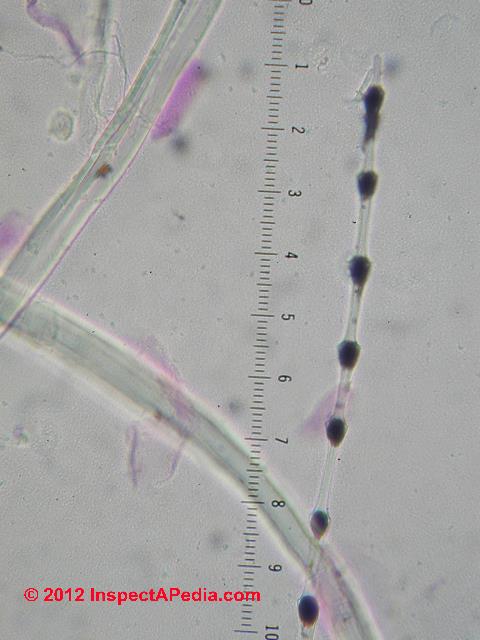 Our forensic lab photo (left) illustrates that fiberglass fibers of quite different diameters can be observed even in the same particle or material sample.
Our forensic lab photo (left) illustrates that fiberglass fibers of quite different diameters can be observed even in the same particle or material sample.
Those dark blobs on the small-diameter vertical fiberglass fiber at the right of our photo are resin. The larger diameter fiberglass fibers in the left of the photo do not happen to carry resin.
One of our clients wrote that her fiberglass-based air conditioning and heating air filters were described by their manufacturer as using fibers of 20-27u (in fiber diameter).
The maker promises the filters do not shed fiberglass fragments and that the fibers are too big in micron size to become repairable even if they do shed.
Laboratory examination of a filter sample sent by the client to an independent microscopy laboratory found that the filter fibers were 31 microns in diameter, and had a blue coating on them [probably the binder, and not the fragments shown in our photos here.].
The binder coating increases the effective fiber diameter.
These measurements of fiberglass fiber diameters were within a normal range of variation in product manufacture that we've seen in own forensic laboratory.
Furthermore, the diameter of a fiberglass air filter fiber is as an indicator of the health hazard should the filter shed fibers is unlikely to be as useful measure as the number of particles released and their overall size.
For example, a fiberglass fiber can break so as to release several sub-micron glass fragments - as we illustrated in our fiberglass fragment photo earlier on this page and in the additional fiberglass fragment photograph below.
This ultra-small (1-5 micron range) fiberglass fragment photo is a digital enlargement of a photograph we took at 1,900x, close to the practical limits of transmitted or reflected light microscopy.
The actual filtering efficiency of an air filter should not be estimated simply on fiber diameter since more than diameter goes into the filter design, including fiber placement, randomness, average remaining opening diameter, total filter thickness, electrostatic properties of the filter, and other variables such as whether or not the filter has a gasket or is bypassing lots of air around the filter itself.
...
Reader Comments, Questions & Answers About The Article Above
Below you will find questions and answers previously posted on this page at its page bottom reader comment box.
Reader Q&A - also see RECOMMENDED ARTICLES & FAQs
Does this HVAC vent filter use fiberglass?
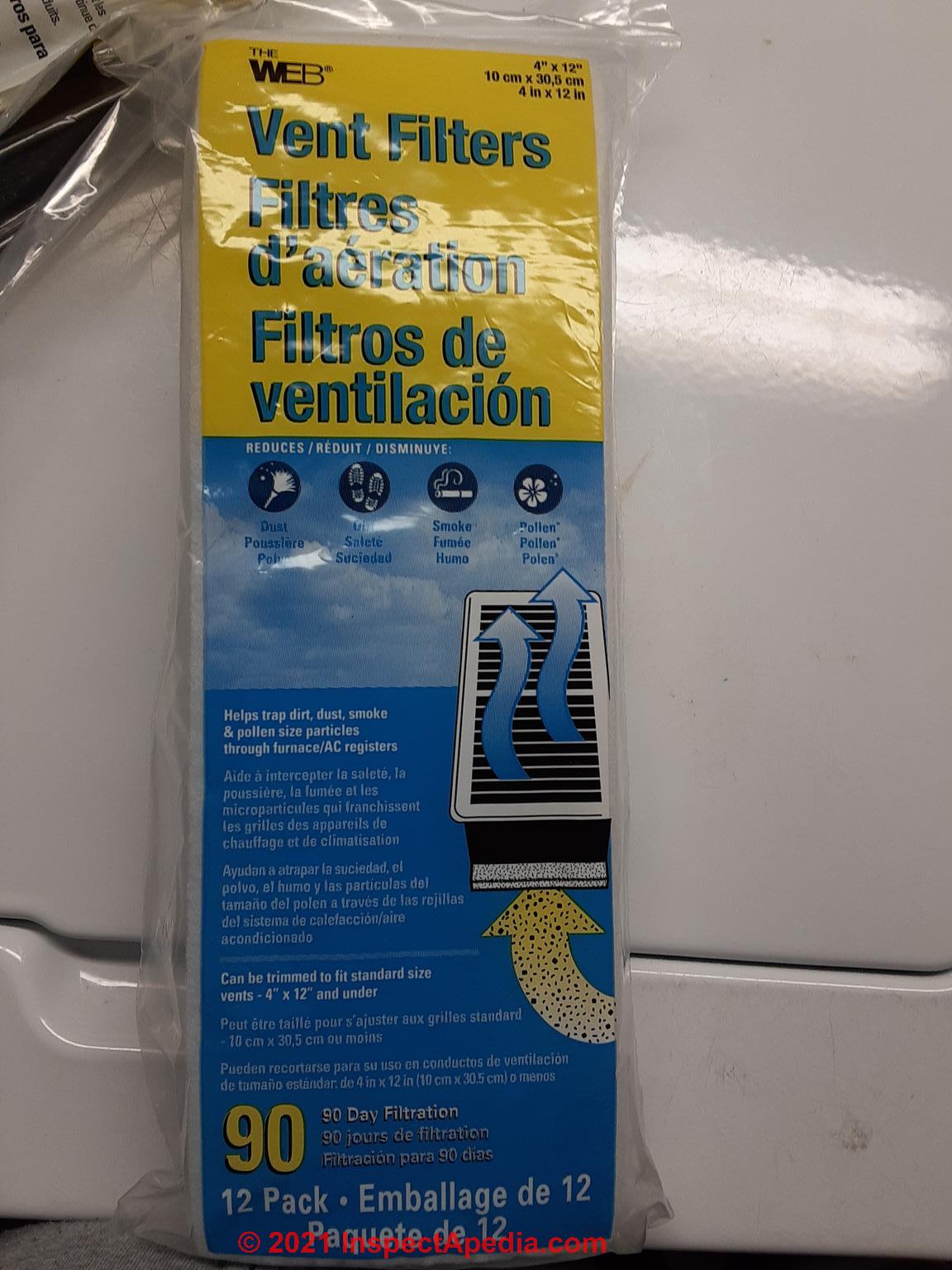 Is it known if this vent filter type has fiberglass particles? As a health care worker:
Is it known if this vent filter type has fiberglass particles? As a health care worker:
Thoughts of using it in a fabric mask to aid in filtering against Covid 19. On 2020-04-07 1 by Wanda -
Reply by (mod) -
Wanda
please see your question and our detailed reply
now found
at AIR FILTER MATERIAL RE-PURPOSED for FACE MASKS
and let me know what you think, what questions remain, or any other comments you can offer
Thank you for asking this important question.
Reader opinion: Get out of fiberglass-contaminated homne
carol.glassman@icloud.com I have been suffering from a fiberglass allergy for almost 5 years.
It happened after storm Sandy and the fiberglass scott went and became airborne. I still haven’t found a doctor anywhere who can help me out with this problem.
I have sores in my scalp, my back and my arms and legs.
My feet and hands get numb very easily and are very painful. I’ve lost a great deal of hair and my teeth and I am so broken down badly. Please don’t stay in your home like I did. It’s ruined my health and I still can’t find any help! - On 2019-05-11 carol.glassman@icloud.com
Reply by (mod) - Critical to get help from your doctor
Carol
Start by asking your physician who know you for a referral. If that's not forthcoming you can find a directory of doctors who specialize in environmental medicine at our website
at MOLD DOCTORS - ENVIRONMENTAL MEDICINE
Water damage crew left wet fiberglass in my home
Hello,
We had a crew not do such a great job removing water damage from our home. They left wet fiber glass insulation in and decided to put fans on it, which just pushed around fiber glass particles into the air. Also they did not cover the return vent.
Currently the furnace is off and just the air scrubber and dehumidifier are running.
I have a 9 month old child and i worry that the furnace filter would not be able to remove the fiber glass particles brought in by the return vent.
Is this a high risk to our child? what steps do you recommend to mitigate this? Is it dangerous to keep a child in the house under this situation?
Thanks! - On 2017-04-13
by Amy
Reply by (mod) -
Amy
When I read of a water damage job that includes such a short cut as you describe I have little confidence that there were not other incompetent or ineffective steps taken during the work.
Proper procedure is to remove wet fiberglass from the building, fix the water source, dry and clean the affected areas. Leaving wet fiberglass building insulation in place is improper and risks having to do the job over again later to remove mold or other contaminants.
Unfortunately, opinion alone isn't enough to bet your health or that of your child. With no objective data one can't assess the risk of fiberglass (nor mold from wet fiberglass) in a building of unknown condition and unknown extent of water damage.
The concerns are greater than fiberglass fragments as leaving wet fiberglass in a building that has been wet invites mold growth that can show up later as a new, expensive remeditaion requirement.
You need an onsite expert familiar with water damage and mold remediation who can inspect the entire building, identify the extent of original water damage and the extent of cleanup and thus to identify what remaining work is needed.
On 2018-11-26 Jennifer
AMY:
I came across your question regarding any risks to your child. I have a 1 year-old I am concerned about due to our apartment being contaminated with fiberglass (origin is still unknown). It is everywhere! There's even fibers in our frozen food in the freezer. It's going on 2 months, and I'm very worried about our health!
Were you able to receive any advice from here, and what ended up happening with your situation? Thanks in advance!
(HELP/ ADVICE FROM ANY ONE ELSE IS GREATLY APPRECIATED)Reply by (mod) -
Jennifer, it seems that we need some objective data to be sure that the contamination that you are concerned about it's actually fiberglass.
It it's difficult to understand how airborne fiberglass contamination in your home would be contaminating food in your freezer.
Perhaps you should collect some samples of Representative material that concerned you and have them examined by forensic lab.
Often if there is fiberglass we can describe its characteristics such as color and resin color that will help track to a source.
...
Continue reading at FIBERGLASS HAZARDS or select a topic from the closely-related articles below, or see the complete ARTICLE INDEX.
Or see these
Recommended Articles
- AIR FILTERS for HVAC SYSTEMS
- AIR FILTER MATERIAL RE-PURPOSED for FACE MASKS
- AIRBORNE PARTICLE SIZE DEFINITIONS & TYPES
- AIRBORNE PARTICLE SIZE TABLE
- ASBESTOS HVAC DUCTS & FLUES field identification photos and guide
- FIBERGLASS HAZARDSIndoor Air Quality Investigations: Fiberglass in Indoor Air, HVAC ducts, and Building Insulation
Suggested citation for this web page
FIBERGLASS & AIR FILTERS at InspectApedia.com - online encyclopedia of building & environmental inspection, testing, diagnosis, repair, & problem prevention advice.
Or see this
INDEX to RELATED ARTICLES: ARTICLE INDEX to AIR CLEANERS FILTERS PURIFIERS
Or use the SEARCH BOX found below to Ask a Question or Search InspectApedia
Or see
INDEX to RELATED ARTICLES: ARTICLE INDEX to FIBERGLASS HAZARDS
Or use the SEARCH BOX found below to Ask a Question or Search InspectApedia
Or see
INDEX to RELATED ARTICLES: ARTICLE INDEX to BUILDING INDOOR AIR QUALITY IAQ
Or use the SEARCH BOX found below to Ask a Question or Search InspectApedia
Ask a Question or Search InspectApedia
Try the search box just below, or if you prefer, post a question or comment in the Comments box below and we will respond promptly.
Search the InspectApedia website
Note: appearance of your Comment below may be delayed: if your comment contains an image, photograph, web link, or text that looks to the software as if it might be a web link, your posting will appear after it has been approved by a moderator. Apologies for the delay.
Only one image can be added per comment but you can post as many comments, and therefore images, as you like.
You will not receive a notification when a response to your question has been posted.
Please bookmark this page to make it easy for you to check back for our response.
IF above you see "Comment Form is loading comments..." then COMMENT BOX - countable.ca / bawkbox.com IS NOT WORKING.
In any case you are welcome to send an email directly to us at InspectApedia.com at editor@inspectApedia.com
We'll reply to you directly. Please help us help you by noting, in your email, the URL of the InspectApedia page where you wanted to comment.
Citations & References
In addition to any citations in the article above, a full list is available on request.
- Thanks to Mark Cramer, Tampa Florida, for assistance in technical review of the "Critical Defects" section and for the photograph of the deteriorating gray Owens Corning flex duct in a hot attic. Mr. Cramer is a Florida home inspector and home inspection educator.
- Our recommended books about building & mechanical systems design, inspection, problem diagnosis, and repair, and about indoor environment and IAQ testing, diagnosis, and cleanup are at the InspectAPedia Bookstore. Also see our Book Reviews - InspectAPedia.
- In addition to citations & references found in this article, see the research citations given at the end of the related articles found at our suggested
CONTINUE READING or RECOMMENDED ARTICLES.
- Carson, Dunlop & Associates Ltd., 120 Carlton Street Suite 407, Toronto ON M5A 4K2. Tel: (416) 964-9415 1-800-268-7070 Email: info@carsondunlop.com. Alan Carson is a past president of ASHI, the American Society of Home Inspectors.
Thanks to Alan Carson and Bob Dunlop, for permission for InspectAPedia to use text excerpts from The HOME REFERENCE BOOK - the Encyclopedia of Homes and to use illustrations from The ILLUSTRATED HOME .
Carson Dunlop Associates provides extensive home inspection education and report writing material. In gratitude we provide links to tsome Carson Dunlop Associates products and services.


